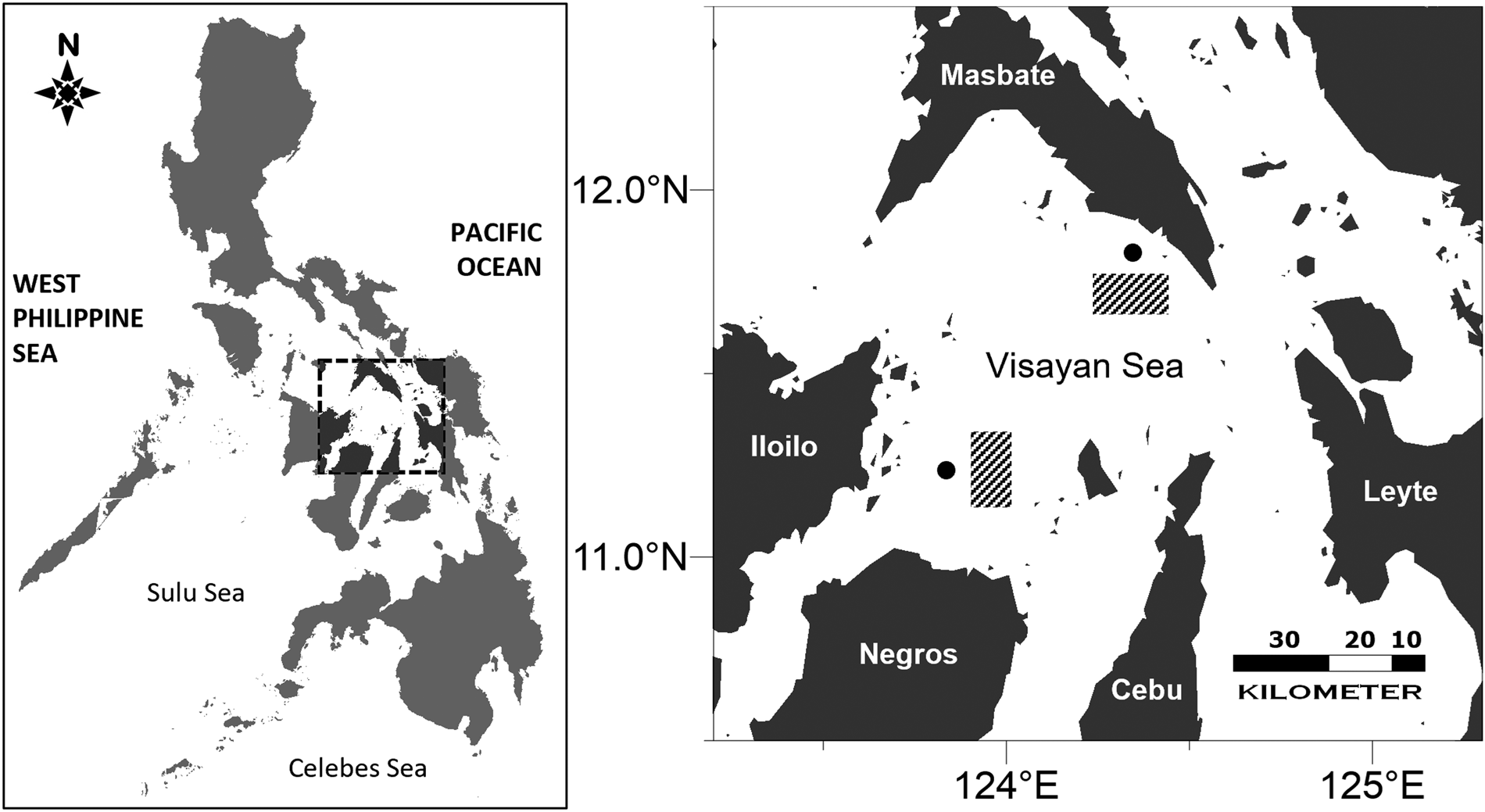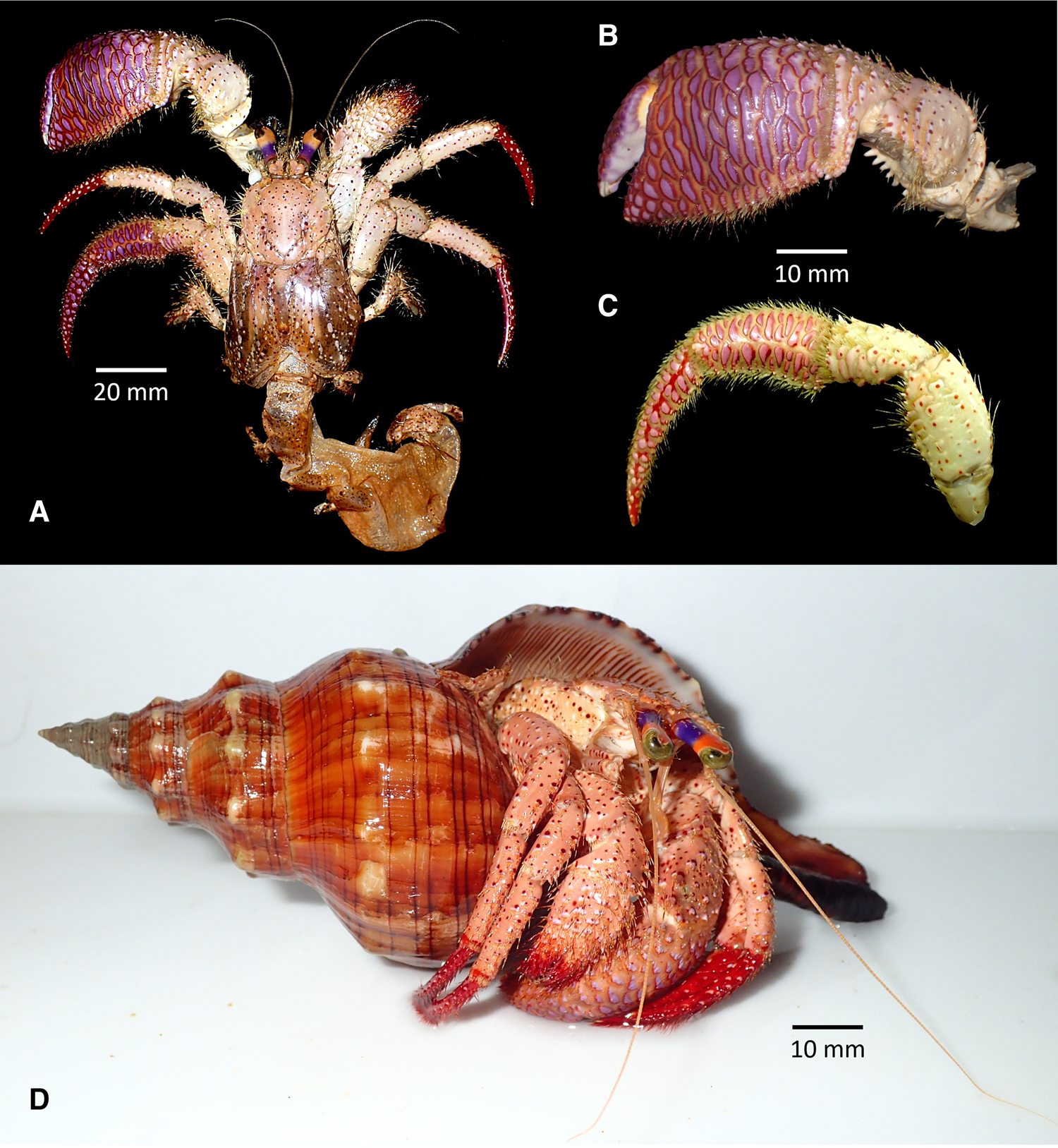Introduction
Over 150 species of hermit crabs have been documented from the Philippines from the families Coenobitidae, Calcinidae, Diogenidae, Paguridae, Parapaguridae and Pylochelidae (Malay et al., Reference Malay, Rahayu and Chan2018; Komai & Rahayu, Reference Komai and Rahayu2021). The genus Dardanus, a large calcinid hermit crab, is known to occur in marine habitats worldwide from shallow waters to deeper slopes (Lemaitre & McLaughlin, Reference Lemaitre and McLaughlin2021). Presently, there are 46 accepted species of Dardanus listed in the World Register of Marine Species (Lemaitre & McLaughlin, Reference Lemaitre and McLaughlin2021). Fifteen species are known to occur in the Philippines including the recently described species, Dardanus balhibuon from Pamilacan Island, Bohol, central Visayas region (Malay et al., Reference Malay, Rahayu and Chan2018).
The Visayan Sea, bordered by Masbate, Northern Iloilo, Northern Negros and Northern Cebu, is one of the most productive and diverse fishing grounds in the Philippines (Hermes et al., Reference Hermes, Armada, Aparri, Zaragoza and Lohmeyer2004; Mequila & Campos, Reference Mequila and Campos2007) and is part of the Coral Triangle global centre of marine biodiversity (Stehli et al., Reference Stehli, McAlester and Helsley1967; Carpenter & Springer, Reference Carpenter and Springer2005; Hoeksema, Reference Hoeksema and Renema2007). However, in the past decades the Visayan Sea has been under high pressure from multiple threats, causing a decline in species richness of reef-associated fishes (Nañola et al., Reference Nañola, Aliño and Carpenter2011) and overexploitation of commercially important marine species (e.g., Guanco et al., Reference Guanco, Mesa, Belga and Nunal2009; Del Norte-Campos et al., Reference Del Norte-Campos, Lapara and Sanchez2021). High fishing pressure in the Visayan Sea could also harm bycatch species including crustaceans such as hermit crabs, which may be of negligible economic importance yet play a significant role as a food source for many larger marine organisms.
The diversity and distribution of tropical Indo-West Pacific marine decapods is still poorly known, and the knowledge gap is particularly acute for deeper water species. In this study, we took advantage of incidental bycatch in fish traps laid at 30–40 m to report for the first time the occurrence of a strikingly coloured and large-bodied hermit crab, Dardanus callichela Cook, Reference Cook1989.
Materials and methods
The specimens were collected off two islands in the Visayan Sea: Nagarao Island in Masbate Province (11.673915°N–11.741104°N 123.773909°E–123.896744°E; collection date 26 August 2019) and Baliguian Island in Concepcion, Iloilo Province (11.143460°N–11.252414°N 123.402144°E–123.476194°E; collection date 6 November 2019) (Figure 1). The specimens were incidentally caught together with fish (mostly breams) in traps of various sizes (not more a square metre) deployed at about 30–40 m. Fishers noted that hermit crabs are a common bycatch of their traps. Specimens were purchased from the fishers and were preserved in 90–95% analytical grade ethanol and brought to the laboratory for identification and systematic examination. Names were checked for validity against the World Register of Marine Species (Lemaitre & McLaughlin, Reference Lemaitre and McLaughlin2021). Specimens are deposited in the Philippine National Museum, Manila (NMCR).

Fig. 1. Location of the Visayan Sea showing the islands (filled circles) and adjacent areas (rectangles) where the specimens were collected.
The shield length, carapace length, ocular peduncles, carpus length and carpus width were measured using digital vernier callipers. Shield length (SL) was measured from the midline of rostral lobe to the posterior cephalothoracic shield.
For the genetic analysis, DNA was extracted from two specimens using Vivantis GF-1 Tissue DNA Extraction Kit (Vivantis Technologies, Selangor, Malaysia). A 660-bp fragment of the cytochrome c oxidase I (COI) mitochondrial gene was amplified using the degenerate Folmer primers dgLCO and dgHCO (Meyer, Reference Meyer2003) and using the following thermocycler conditions: an initial denaturation for 1 min at 95°C; 37 cycles of denaturation for 40 s at 95°C, annealing for 40 s at 42°C, and extension for 40 s at 72°C; and final extension for 1 min at 72°C (following Meyer, Reference Meyer2003). PCR products were cleaned using the Vivantis GF-1 PCR Clean-up kit then sent to a commercial sequencing facility. Resulting chromatograms were checked and edited using Chromas 2.6.6 (Technelysium Pty Ltd, 2018) and assembled into contigs using Unipro UGENE (Okonechnikov et al., Reference Okonechnikov, Golosova and Fursov2012). Sequences were deposited in GenBank [ON807356, ON807357] while the voucher specimens were deposited in the National Museum of the Philippines [NMCR 9102–9105]. GenBank contains COI sequence data for less than half of the extant 46 Dardanus species, with taxonomic coverage biased towards shallow-water species. Given the low and biased taxonomic coverage, and the little resolving power of the COI gene at deeper nodes, we deemed it premature to do phylogeny reconstruction.
Results
Taxonomic account
Genus Dardanus Paul'son, Reference Paul'son1875
Dardanus callichela Cook, Reference Cook1989
Pagurus imbricatus – Alcock, Reference Alcock1905: 92, pl. 9, figure 8; Fize & Serène, Reference Fize and Serène1955: 220, figure 35A–C, pl. 6, figures 11–14 (Not Dardanus imbricatus Milne Edwards, Reference Milne Edwards1948).
Dardanus callichela – Cook, Reference Cook1989: 115–117, figures 3, 6B, 8A.
Dardanus callichela – Rahayu, Reference Rahayu1996: 338; Rahayu & Wahyudi, Reference Rahayu and Wahyudi2007: 13; McLaughlin, Reference McLaughlin2002: 427–428; Xiao et al., Reference Xiao, Wang and Sha2014: 212–215, figures 1 & 2.
Material examined. One male SL 19.5 mm (BIPH1901/NMCR99102/GenBank accession number ON807356), Baliguian Island, Iloilo, Philippines; one ovigerous female 14.4 mm SL (BIPH1902/ MCR99103/GenBank accession number ON807356), Baliguian Island, Iloilo, Philippines; one ovigerous female 20.1 mm SL (BIPH1903/NMCR99104), Baliguian Island, Iloilo, Philippines; one damaged female 18.1 mm SL (NIPH1904/NMCR99105), Nagarao Island, Masbate, Philippines. Other measurements are presented in Table 1.
Table 1. Morphological measurements and observations of the four specimens of D. callichela collected in the Visayan Sea, Philippines

M, male; F, female; OF, ovigerous female; D, damaged.
Brief description
Ocular peduncles shorter than antennular peduncles; cornea diameter one-third of ocular peduncle; ocular acicles broad, well separated basally, with 3 spines on distal margins.
Palm of left cheliped with a row of 4–7 spines on the upper inner margin, outer surface strongly convex and scutellated, with flat fringe of plumose setae on the distal edge of each scute; lower margin with brush of long plumose setae partially concealing robust spines. Carpus with row of spines on upper margin, smaller spines on upper half of outer surface, spinose scutes on lower half. Ambulatory legs with dactyls longer than propodi. Dactyl of left third pereopod bordered by dense brush of long bristles and plumose setae, dorsal and ventral margins with row of long sharp spines partially obscured by setae; lateral surface flattened, with smooth, longitudinal, median area, sometimes ill-defined and flanked by transverse scutes with flat fringe of plumose setae on distal edge of each scute. Propodus with row of large simple and multifid spines on the dorsal and ventromesial margins, partly concealed by brush of long plumose setae; lateral surface convex, with 2 rows of scutes. Carpus with spinose scutes fringed distally with plumose setae on lateral face; dorsal surface with some spines, tufts of setae, and bristles; mesial face smooth, slightly convex, with 3–5 large spines on ventrodistal margin, 2 large and 2 small spines on dorsodistal margin.
Telson with roundly triangular, slightly asymmetrical posterior lobes; oblique terminal and rounded lateral margins armed with several spines.
Fresh colouration. Body cream-coloured with scattered red and white dots. Dactylus of left second pereopod, right second pereopod, right third pereopod, and distal half of fingers of right cheliped brick red, with white blotches at the base of tufts of bristles. Scutes on fingers and palm of left cheliped and outer surface of left third pereopod pink-lilac bordered with red. Ocular peduncles proximal half royal purple, bordered by red-orange proximally, distal half light orange.
Remarks
Dardanus species that closely resemble D. callichela include D. imbricatus (Milne Edwards, Reference Milne Edwards1848), D. corrugatus Cook, Reference Cook1989, D. squarrosus Cook, Reference Cook1989 and D. undulatus (Balss, Reference Balss1921) (Cook, Reference Cook1989). This species group is easily distinguished from all other Indo-West Pacific Dardanus by the degree of sculpturing on the outer surface of the left cheliped, which is consistent with our specimens (Figure 2A & B). Dardanus callichela and D. imbricatus can be distinguished from D. corrugatus, D. squarrosus and D. undulatus by the length of their eyestalks. All four specimens examined in this study have short eyestalks, where the eye diameter is 1/3 of the eyestalk length, consistent with both D. imbricatus and D. callichela. Dardanus imbricatus is then separated from D. callichela by the presence of tubercles on scutes of the left cheliped and the smooth surface of the outer face of carpus of the third left leg (Cook, Reference Cook1989). The collected specimens do not have tubercles on scutes on the left cheliped (Figure 2B) and the outer surface of carpus of the third pereopod (Figure 2C) is scutellated, not smooth. In addition, the colouration of fresh specimens (Figure 2) closely matches colour notes on recently preserved specimens (Cook, Reference Cook1989). Therefore, we identify the specimens as D. callichela, a new record for the Philippines, bringing the total count of Dardanus in the country to 16 species.

Fig. 2. Dardanus callichela. (A) Dorsal view, (B) left cheliped, (C) left third pereopod, (D) live specimen inside a Filifusus filamentosus shell. (A–C) NMCR99105; (D) NMCR99104.
Distribution
Indo-West Pacific: Sri Lanka; Gulf of Thailand; South China Sea; NW Australia; Coral Sea; Singapore; Visayan Sea, Philippines (Figure 3). From 30–88 m and one questionable report from 350 m.

Fig. 3. Recorded distribution of Dardanus callichela in the Indo-West Pacific region (yellow filled circles) including the new record in the Philippines (red filled circle).
Discussion
Dardanus callichela is found in waters >30 m from only a handful of Indo-West Pacific locations. However, as with other deeper-water species, its true distribution may be more extensive. Deeper waters are rarely explored, and its inhabitants are sometimes erroneously classified as rare or endemic (Mendoza et al., Reference Mendoza, Naruse, Tan, Chan, Richer de Forges and Ng2010). The new record of D. callichela from the Philippines was due to fortuitous collection of bycatch from fish traps set by municipal fishers in the Visayan Sea. Bycatch from traps and other low-cost artisanal methods such as tanglenets (Mendoza et al., Reference Mendoza, Naruse, Tan, Chan, Richer de Forges and Ng2010) can be explored as alternative survey methods for deep benthic habitats that are inaccessible through conventional scuba diving surveys.
Dardanus is in need of a global taxonomic revision (Landschoff, Reference Landschoff2018) to resolve species complexes; date divergences between Indo-West Pacific, East Pacific and West Atlantic taxa; and understand key evolutionary events, such the transition between deep- and shallow-water species. While the molecular data currently available for the genus is insufficient to resolve these questions, sequence data from rarer, deeper-water species such as D. callichela will be instrumental in fully resolving the phylogeny of the genus Dardanus.
Acknowledgements
Special thanks to the LGUs of Concepcion, Iloilo and Placer, Masbate for the assistance during our stay, and the fisherfolks for their help in collecting the specimens. We thank Dianne Penuela for helping with laboratory work and Ayen Ajos and Yuling Chang for helping the authors translate some papers. The OceanBio and Marine Bio Labs of UPV are thanked for making the field surveys a fun experience.
Author contributions
Study conception and design: LRF, MACM, MCDM; Data collection: LRF, MACM, MCDM, KCSE, WLC; Analysis and interpretation of results: LRF, MACM; Wrote first draft: MACM, LRF; Revision and edits to manuscript: LRF, MACM, MCDM, KCSE, WLC; Final approval of submitted manuscript: all authors.
Financial support
This work was supported by the Visayan Sea MPA Project under Fish Right Program funded by USAID (WLC) and the Taklong Barcoding Initiative UPV OVCRE in-house project (MCDM).
Ethical standards
This study does not contain sampling procedure and technique involving vertebrates and regulated invertebrates performed by any of the authors. The specimens were purchased from the fishers, thus no collection permits were required.






